 The Batman universe ought to have been fertile video game ground for years now. It has everything: a righteous yet complicated hero, a solid cast of supporting characters, and probably the best villains of any comic universe. But Batman video games have tended to be forgettable disappointments.
The Batman universe ought to have been fertile video game ground for years now. It has everything: a righteous yet complicated hero, a solid cast of supporting characters, and probably the best villains of any comic universe. But Batman video games have tended to be forgettable disappointments.
That changed with Rocksteady studio’s Batman: Arkham Asylum. Released in September 2009, Arkham Asylum blew the video gaming world away with its great story, tight yet layered game play, and its crisp, atmospheric visuals. Asylum put Batman in a sprawling, gritty and Gothic world worthy of him, and set him up against the usual villains in a way that was true to the comic books, yet grown-up, fresh and even real. Asylum got the details right from Batman’s gadgetry to the rats and roaches infesting the creepy island sanitarium, and by staying away from the TV cartoons and both the Tim Burton and Christopher Nolan movie versions of the franchise, created its own viable space in the Batman culture. Asylum won game of the year awards and was the first real runaway hit in Batman video gaming.
Rocksteady’s Batman returned this week to an expectant gaming universe, in a huge new adventure called Batman: Arkham City. Its release has been the equivalent of a big movie opening; one Gamestop near me had an opening night party that included a screening of The Dark Knight, food and giveaways leading up to the midnight hour when discs could go home with gamers. The game’s trailer promised to deliver a massive, open world with you at the center, as Batman. Sign. Me. Up.
As the title implies, in the second episode Batman is no longer confined to an island asylum in Gotham harbor. The mayor of they city has taken Gotham’s villains, the thugs and the insane, walled off a chuck of downtown, and put them there in what amounts to a kind of free range madhouse. As you might imagine, both Bruce Wayne and Batman have a problem with this and decide to investigate. Dr. Hugo Strange presides over the insanity, and opens the game threatening to expose Batman’s deepest secrets.
So there’s your setting: Every major Batman villain lurking or ruling within some part of an ultraviolent, even sadistict, world, called Arkham City. This, as you might have guessed, isn’t really a kid’s game. The grit comes with some coarse language, so parents might want to keep that in mind when evaluating whether to buy the game. It comes with a teen rating for a reason.
I’ve only put about an hour into the game, following Tuesday night’s GOP presidential debate, but so far Arkham City surpasses the brilliant original while bringing the best parts of Asylum forward. The story so far is again, tight and intriguing. The visuals are striking and detailed, as in the original, but perhaps a bit better looking. The atmospherics are dead on dark and fun, a Halloween party on steroids. By moving Batman from an island to a large slice of Gotham, Arkham City opens play to a massive new level. Arkham Asylum never felt confining except in the tunnels and spaces where it should, but City delivers, well, a city. Batman can swing, glide and grapnel from the tops of cathedrals and courthouses to the streets and sewers across great distances, battling thugs and interrogating inmates along the way. In the span of just an hour or so, the game already introduced Catwoman (as a playable character), Two-Face with his dual nature, the Penguin, Harley Quinn and the Joker. But they’re introduced and used in a way that works with and moves the story, and they’re not over-the-top or cartoony. Catwoman is lithe and ambiguous. Two-Face is a horror Hamlet. Penguin is a drab, evil little man seeking revenge. Joker is the nasty, creepy clown with scars and an army of henchmen in make-up that he was in Arkham Asylum. Or so he seems; I haven’t actually seen him yet but he has injected himself into the storyline with a sniper’s shot. And the Riddler is already in the background, hiding trophies and taunting Batman from the shadows, just as he did in the original. City’s opening set pieces are not villain overload, but just good Batman fun.
One of Arkham City’s great strengths so far is just how open the play is. You’re not on rails or locked into following the story immediately. Once you’re past the first few segments, which alternate cut scenes with game play, you’re Batman. You can follow the story or you can treat Arkham City as your sandbox. You have several of his gadgets at your disposal, including the Batclaw, the Batarang, the grapnel, an explosive gel, and his detective vision that allows him to see weaknesses in structures, armed enemies, hidden features and crawl spaces, and more. Armed with those gadgets and let loose in the city, you’re free to just play Batman if you want. Climb buildings. Leap off them and glide over city block after city block. Drop down and beat down some villainous henchmen and then drop a smoke bomb and disappear. Sit up on a gargoyle or flagpole and check out the scene. It’s up to you and how quickly you want to progress through the tale. It’s also up to you how you fight the game’s thugs and villains. Stealth, knuckles and boots, Batarangs, Batclaw and explosives — it’s up to you.
The game isn’t perfect. It’s a bit too easy to just get lost by falling off a building or over-flying your goal. The remote control Batarang still takes some getting used to when you’re learning how to control it. But to the extent that those are even flaws — and they’re not, really — they don’t get in the way of what looks like it’s going to be an epic Batman adventure. Other reviews I’ve seen give Batman: Arkham City either 9 out of 10 or even 10 out of 10. So far, it’s a 10 to me. Batman: Arkham City is attracting a lot of hype and acclaim, and it deserves both.
Next stop: Arkham Nation? I hope so.









Join the conversation as a VIP Member